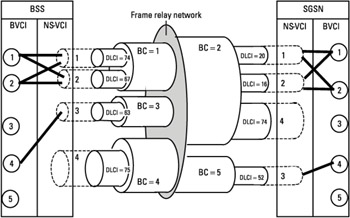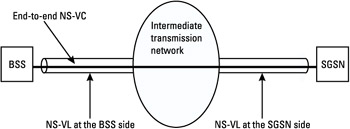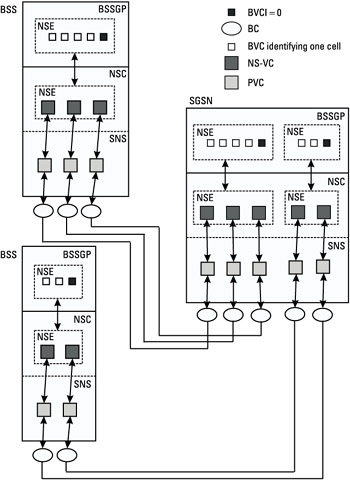Addressing over Gb
6.3 Addressing over Gb
Addressing over Gb is performed over virtual connections. At NS and BSSGP layers, each entity communicates with its peer through this kind of connection. The goal of this section is to explain the hierarchy that has been defined between the different virtual connections and to introduce the technical words that are used in the standard for the description of the Gb interface.
Addressing is very simple, but it requires an understanding of basic concepts that will be introduced in the following sections. Once these concepts have been presented, a global overview of addressing will be given.
Figure 6.6 provides an overview of the different levels of addressing on the Gb interface. We will return to this figure later in the chapter.
 Figure 6.6: Addressing on the Gb interface.
Figure 6.6: Addressing on the Gb interface.
6.3.1 Bearer Channel
A bearer channel (BC) is a physical channel that carries all the frame relay signaling and data. A BC could be a n × 64 Kbps channel on a pulse code modulation (PCM) link (2,048 Kbps for a European E1 link; 1,544 Kbps for an American T1 link). The PCM link is the typical transmission link that is used in telecom networks.
| Note |
As a BC can be mapped on a restriction of a PCM link, it is possible for an operator to share this link between GPRS packet transfer (Gb interface) and circuit-switched (A interface). |
6.3.2 PVC
The frame relay PVC was introduced in Section 6.2. It allows the multiplexing of different flow on the BC. The BC can support several PVCs. At BSS side, a DLCI, which can be different from the one at the SGSN side, identifies a PVC.
| Note |
There is a dedicated DLCI (DLCI = 0) that is used for signaling purposes (link management). This DLCI does not identify a PVC. |
6.3.3 Network Service Virtual Link
An SGSN and a BSS can be connected directly via a physical link or they can be connected indirectly because of intermediate equipment or transmission networks (frame relay network), in which case different physical links are used.
The concept of the network service virtual link (NS-VL) is introduced to identify the link defined by a PVC and its supporting BC. Each NS-VL is identified by a network service virtual link identifier (NS-VLI). An NS-VL is supported by only one physical link, and several NS-VLs can be mapped on a physical link. One NS-VLI corresponds to the association DLCI and BC identifier.
6.3.4 Network Service Virtual Connection
As described previously, the NS layer has been split into two sublayers, SNS and SNC, in order to have the SNC sublayer independent of the intermediate transmission network (frame relay). In order to provide an end-to-end connection between the BSS and the SGSN irrespective of the exact configuration of the Gb interface and transmission network, the concept of network service virtual connection (NS-VC) has been introduced at the SNC layer.
NS-VCs are end-to-end virtual connections between the BSS and the SGSN. Each NS-VC is associated with one PVC at the SNS layer. Each NS-VC is identified by an NS-VC identifier (NS-VCI) that has end-to-end significance across the Gb interface. NS-VCs as PVCs are statically configured by the network operator by operations and maintenance (O&M) means. Figure 6.7 shows the relationship between NS-VCs and NS-VLs.

Figure 6.7: Relationship between NS-VCs and NS-VLs. (From- [1].)
6.3.5 Network Service Entity
A network service entity (NSE) is composed of a group of NS-VCs; it provides a communication service to the NS user peer entities (SGSN or BSS). A network service entity identifier (NSEI) identifies each NSE that has end-to-end significance across the Gb interface. The NSE at each side of the Gb interface manages the traffic from or to a group of cells.
One SGSN can be linked to several BSSs. The NSE and NSEI concept can be used to identify the different BSSs connected to the same SGSN. Each BSS is identified by an NSEI on the SGSN side. A group of NS-VCs is defined within the NSE identified by the NSEI to communicate with the BSS. It could also be possible to define one NSE per board in the BSS or per physical link connected to the BSS. This is completely implementation dependent.
One NSE and the group of NS-VCs that it integrates are defined by the network operator through O&M means. The interest in having several NS-VCs within one NSE is to distribute the traffic from all the cells belonging to this NSE. In case of a problem on one NS-VC, the traffic is not interrupted and is transferred over the other links.
6.3.6 BSSGP Virtual Connection
BSSGP virtual connections (BVCs) are end-to-end virtual connections between the BSS and the SGSN at BSSGP layer. A BVC is identified by a BVCI that has an end-to-end significance across the Gb interface. An NSE is associated with a set of BVCs that are dynamically mapped onto its corresponding NS-VCs.
Two kinds of BVC have been defined:
-
PTP BVCs are dedicated to the GPRS traffic of one cell (all the traffic and signaling dedicated to this cell is transmitted via the corresponding BVC);
-
Signaling BVCs handle the signaling of the NSE to which they belong.
At the SGSN side, the association BVCI, NSEI identifies one cell.
In the BSS, the BVCIs are statically configured by administrative means. At the SGSN side, BVCIs associated with PTP functional entities are dynamically configured, and BVCIs associated with signaling functional entities are statically configured.
6.3.7 Addressing
Figures 6.6 and 6.8 provide a summary of the different concepts presented in the previous sections. In Figure 6.6, two cells 1 and 2 are identified by BVCI = 1 and BVCI = 2. They share the two NS-VCs identified by NS-VCI = 1 and NS-VCI = 2.

Figure 6.8: Example of addressing between several BSSs and one SGSN.
The NS-VC 1 corresponds to the PVC identified by the DLCI = 74 on the BC identified by BCI = 1 at BSS side and DLCI = 20 on the BC identified by BCI = 2 at the SGSN side. The NS-VC 2 is mapped on the PVC identified by the DLCI = 67 on the BC identified by BCI = 1 at BSS side and DLCI = 16 on the BC identified by BCI = 2 at SGSN side.
All the traffic addressed to cell 1 or cell 2 from the SGSN or received in cell 1 or cell 2 in the BSS is transferred on the corresponding BVC at the BSSGP layer. The traffic is dynamically distributed on the NS-VCs identified by NS-VCI = 1 and NS-VCI = 2 at the SNC layer.
Figure 6.8 details the addressing between one SGSN and several BSSs. The SGSN is connected to two different BSSs. The BVCs and NS-VCs of each BSS belong to one NSE; each one is identified by a different NSEI.
One BVC is reserved for signaling purposes. On the SGSN side, BVCs and NS-VCs belonging to the same BSS are grouped within the same NSE. One NSE is created for each BSS. For each NSE, a set of BVCs is mapped onto a set of NS-VCs. There is a one-to-one mapping between NS-VC and PVC. Within one SGSN, one cell within one BSS is directly identified by one BVCI and one NSEI.






